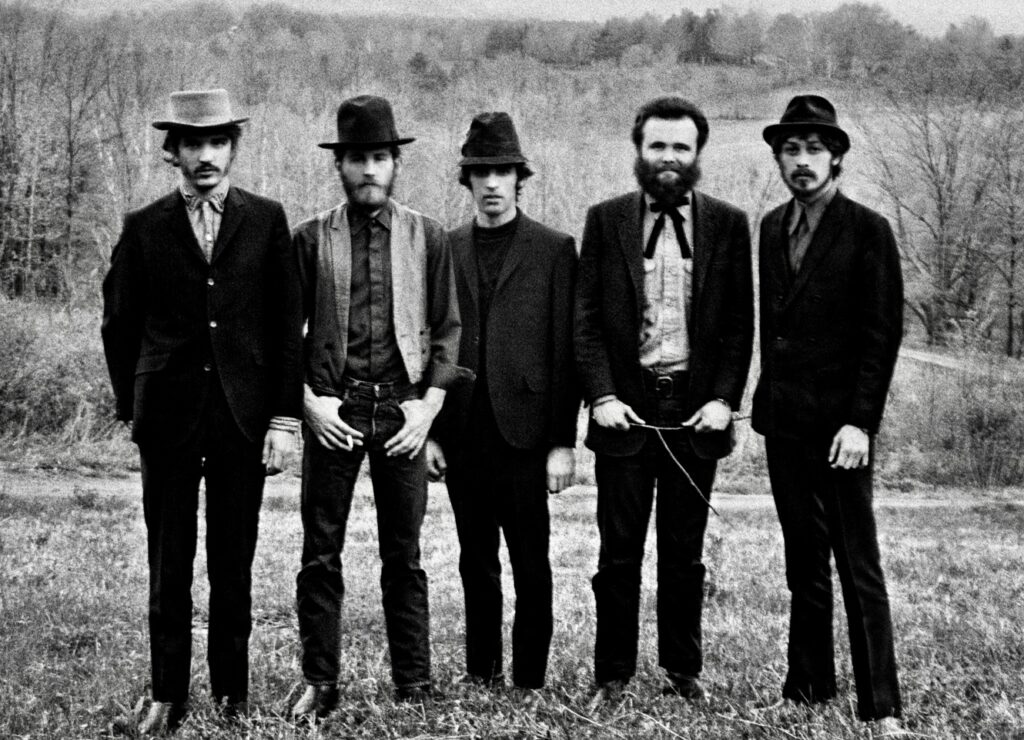
Who were they? Generations that came after The Band’s era may not know. The group came and went in just six years, without touring endlessly like other artists. Bluesman Taj Mahal puts their legend into words: “If there are any American musicians comparable to the Beatles, it’s them.”
This trip down memory lane is guided by the group’s most prolific writer, Robbie Robertson. As a half Native American, half Jewish 16-year-old from Toronto, Canada, his love for music and fluid guitar playing led him to the Mississippi Delta to join the animated rockabilly band Ronnie Hawkins and The Hawks in 1960. A deep friendship developed between the teen and the group’s drummer/singer Levon Helm. Hawkins attracted more young talent from Toronto: bass guitarist/vocalist Rick Danko, Garth Hudson keyboardist/accordion player and Richard Manuel keyboardist/vocals.
Robertson, Helm and the other Torontonians, split off. Their next gig was in 1965 backing Bob Dylan, who was transitioning from folk singer to electric rock and roller. As Dylan and his backup band toured, they were booed. Folk music fans weren’t having it. They wanted their hero on an acoustic guitar, singing solo or with a harmonica in his mouth.
Retreating to an ugly pink house in Woodstock, New York brought the ego-wounded band of brothers to a better place, emotionally, musically and geographically. That’s when they started to create their unique blend of Americana music, with hints of folk, rock, blues and R&B along with exquisite harmonies and an unparalleled musicianship that made them the gold standard U.S. rock band. Eventually they would release 10 studio albums. Compared to the Rolling Stones, who released 30 studio albums over 52 years, and are still together, their career was short.
“The Weight” is their most famous song: “I pulled into Nazareth, was feelin’ about half past dead. I just need some place where I can lay my head…” The vocals are so haunting and glorious it’s as if raspy throated angels are singing into an echo chamber. And the song is so well written it got a new life when Mavis Staple made it one of her standards.
This remembrance, directed by 24-year-old Canadian filmmaker Daniel Roher, edited by Eamonn O’Connor and Roher and shot by Kiarash Sadigh, displays certain reverence for the times and the group. Fifty percent is happy-go-lucky experiences, mostly when Robertson and the guys bonded in their youth and first lived in Woodstock. Fifty percent is about them being beaten down, licking wounds, stops and starts, car crashes, drug and alcohol addiction, breaking apart and then estrangement. It’s the only story the filmmaker can tell, since the material is based on Robertson’s bestselling autobiography Testimony: A Memoir. One point of view.
Robertson is a spiritual guide as a musician. Listen to his post-Band solo albums. when he dabbled in bigger band experimental music (“Testimony”) or embraced his Native American Mohawk culture (“Ghost Dance” with Rita Coolidge and her group Walela’s silky backing vocals), and the thread through his tunes is a layered, hypnotic, mystical and sensitive approach. Enchanting and ethereal, compared to The Band’s vibe, which was gutsy roots music.
Seeing and hearing how the brothers formed the band, loved each other initially and brought that happiness to their music is inspiring on many levels. For the casual music fan, you get the backstory on the group and how they created their most popular tunes. For melophiles, you’re watching musical geniuses at work, handling and mishandling fame and succumbing to destruction.
Interviews with Robertson’s wife Dominique, Bruce Springsteen, Eric Clapton, George Harrison, Van Morrison and Taj Mahal add personal anecdotes and words of admiration. Clips of The Band on the road performing with Dylan are rare and priceless. Iconic photos of the bearded guys wearing hats and dressed in what looks like late 19th century western garb evokes images of the Jesse James gang.
Old conversations with Helm and other band members fill in some cracks. What’s missing is what happened after the glory days. When members started to die off. When Helm was fighting throat cancer and embittered because he didn’t’ receive songwriting royalties, because Robertson wrote the lyrics and music and he did the arrangements. Helm famously gave private concerts in his studio barn in upstate New York to earn enough money to keep the lights on. His coda and examining the bitter feud he had with Robertson would have made this very intriguing documentary feel more complete and objective.
In some ways you want to be grateful that Robertson told his side of the story, through nostalgia, archival footage, photographs, interviews and concert performances. Audiences will likely be happy he’s shed some light on the group, even if it borders on being self-serving.
Others may wish that their last visual recollection of this super group of artists was when they were the focus of the 40-year-old Martin Scorsese concert documentary The Last Waltz. Performing, with help from Muddy Waters, Joni Mitchell, Neil Young, Bob Dylan and Van Morrison, the men who once were brothers end thier final set exiting stage left for the last time. RIP.
Visit NNPA News Wire Film Critic Dwight Brown at DwightBrownInk.com and BlackPressUSA.com.